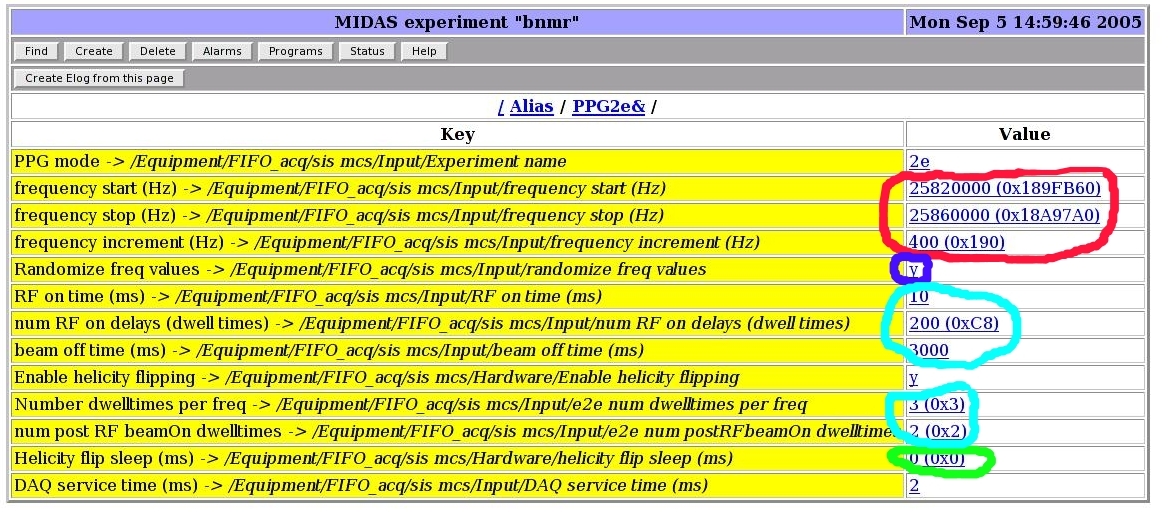
The ISAC β-NMR HomePage
| Introduction to β-NMR |
Publications |
Students Projects |
Contacts |
| Technical Information |
Data Acquistion |
Approved Experiments |
Internal Page |
| Related Links |
BNMR Wiki |
Data Analysis |
Photo Album |
|
|
PPG2e page
To set the frequency range and frequency increment through which the RF will step, modify the values circled in red.
To randomize the frequency stepping, set the value circled in dark blue to "y". To NOT randomize, set it to "n"
To set up for dual mode, set "Helicity flip sleep (ms)", circled in green, and "DAQ service time (ms)" to one (1) . You will also need to "enable dual mode" on the Hardware page.
To set up for single mode (beam only to one station), set the "Helicity flip sleep (ms)" to "2000" (2 sec.) and "DAQ service time (ms)" to "2000" (2 sec.).
To change the time structure of the DAQ, change values circled in light blue.
1) "RF on time" is determined by the
type
of RF pulse you have chosen and by the bandwidth you
have chosen (both changed on the PSM
page) . Let's assume you have chosen the Hermite
function and a bandwidth of 250 Hz (this is different from the
"frequency increment" size which is set on this page!). Then you will
have a
RF pulse duration of about ~9 ms (this is shown under Expert/PPGoutput
page), and you will want to set your "RF on time" to be a little
longer,
say 10ms. THIS IS ALSO THE DWELL TIME that is refered to on all other
pages. DWELL TIME = RF ON TIME
2) If you want to measure T1 at the beginning of the beam pulse (where the asymmetry is high but counts low), you will choose of a value for "num RF on delays". Say you want two seconds of T1 data, then choose 2sec/10ms-per-dwelltime=200 dwelltimes.
3) If you want to measure T1 after the beam is turned OFF, choose a value for "beam off time (ms)". Note that it's in milliseconds, NOT dwell times. When running in dual mode, this can be long (4 or 5 secs.) since the beam is at the other station and you're not wasting time.
4) Say you want to measure T1 after the beam is turned OFF and you want the asymmetry to reach steady-state value after the RF is turned off. Let's assume your tau_prime is 500ms and you want to wait 4 times tau_prime=2sec. You will want to set "num post RF beamOn dwelltimes" to 2 sec./ 10ms-per-dwelltime = 200 dwell times. If you do not wish to do this, leave it at a default of 2 dwell times.
5) If you wish to measure the asymmetry by subtracting neighbouring points before and after RF pulses (subtraction method), choose a value of "Number dwelltimes per freq" which is two (2). This will give you one measurement of the asymmetry before RF, one during and the third will come from the value measured before the next RF pulse. We subtract the first from the third to measure the asymmetry. If you wish to measure the asymmetry by calculating the slopes before and after RF pulses (slopes method), choose a value of three (3) for "Number of dwelltimes per freq": two before the RF pulse (for one slope), one during, and the two after the RF pulse (for the second slope) will come from the measurements before the next RF pulse.
2) If you want to measure T1 at the beginning of the beam pulse (where the asymmetry is high but counts low), you will choose of a value for "num RF on delays". Say you want two seconds of T1 data, then choose 2sec/10ms-per-dwelltime=200 dwelltimes.
3) If you want to measure T1 after the beam is turned OFF, choose a value for "beam off time (ms)". Note that it's in milliseconds, NOT dwell times. When running in dual mode, this can be long (4 or 5 secs.) since the beam is at the other station and you're not wasting time.
4) Say you want to measure T1 after the beam is turned OFF and you want the asymmetry to reach steady-state value after the RF is turned off. Let's assume your tau_prime is 500ms and you want to wait 4 times tau_prime=2sec. You will want to set "num post RF beamOn dwelltimes" to 2 sec./ 10ms-per-dwelltime = 200 dwell times. If you do not wish to do this, leave it at a default of 2 dwell times.
5) If you wish to measure the asymmetry by subtracting neighbouring points before and after RF pulses (subtraction method), choose a value of "Number dwelltimes per freq" which is two (2). This will give you one measurement of the asymmetry before RF, one during and the third will come from the value measured before the next RF pulse. We subtract the first from the third to measure the asymmetry. If you wish to measure the asymmetry by calculating the slopes before and after RF pulses (slopes method), choose a value of three (3) for "Number of dwelltimes per freq": two before the RF pulse (for one slope), one during, and the two after the RF pulse (for the second slope) will come from the measurements before the next RF pulse.

Page last modified: 07/23/09 02:46 by Andrew MacFarlane.